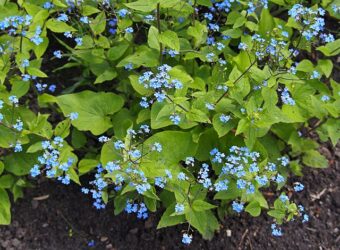In this article, we will discuss how to grow the border perennial Brunnera in containers. Brunnera is the only species of Brunnera that belongs to the genus of Boraginaceae (the Borage or forget-me-not family).
It is a rhizomatous perennial that is native to the woodlands of Eastern Europe and West Asia.

It has the reputation of being easy to grow, thriving in any conditions as long as it is not too dry. If you look at them they look at first glance like a giant forget-me-not -a Myopsis and hence its common name. No matter what, it is a great spring flowering plant. They are not only grown for the flowers but the heart-shaped or oval leaves that are often variegated or have a silver sheen to them. The leaves also have a rough, hairy texture and are evergreen in warm climates.
Towering over the leaves are the dainty blue flowers so common with members of the borage family. They will simply look stunning in containers.
Find out how to grow this perennial in a container in this article.
GROWING BRUNNERA IN CONTAINERS
Although you can grow from seed, it is easier and more available as garden-ready plants. You can also have more choice of what plants you can grow in containers.
First, choose a container that will suit the plant in question and is well-proportioned. Whatever you choose, make sure it has plenty of drainage holes in them. To this container add a 1cm layer of gravel to aid drainage. On top of this add a good quality multipurpose compost to which handfuls of manure have been added to within 5cm of the rim.
Dig a hole at the centre slightly bigger than the root ball it came in the original container, Place the plant in so that the top of the root ball is at the same level as the top surface of the compost. Backfill with the growing media so that the plant is snug and no gaps remain, using more compost if necessary. Firm the plant in and water well.
CARE INSTRUCTIONS

Brunnera prefers to be grown in the shade, so great for those who want plants that do well where the sun does not shine. You will need to water especially so in dry, hot weather and when 5cm below the top of the surface of the compost feels dry to the touch, never allow the compost to dry out at all.
You will need to give an annual dressing of slow-release fertilizer to get it through the growing season. No additional feeding will be required.
You will need to deadhead after flowering as this will prevent the plant from readily self-seeding or not if you do want seedlings to appear everywhere.
Prune spent flowering spikes once they start to die back. Remove any unsightly leaves and dead leaves as soon as they appear.
PESTS AND DISEASES
Luckily Brunnera is pests and diseases free as they seem to avoid them. If you are unlucky they may suffer from powdery mildew, which is best avoided by ensuring that there is good air circulation around and in the plant. You will also need to make sure the compost is never too dry.
VARIETIES TO GROW
As stated in the introduction, there is one species Brunnera macrophylla that all produce blue flowers. All growing up to 60cm high and you have plenty of varieties to choose from.
‘Jack Frost’ with large silver heart-shaped leaves with a metallic sheen to where sprays of sky blue flowers appear.

‘Alexander’s Great’ has large, silvery foliage that is ovate and is heavily silver veined.
‘Sea Heart’ has silvery-green leaves with grey-green veining.
‘Silver Heart’ has silvery heart-shaped leaves with a beautiful moonlight shimmer.
‘Silver Charm’ has silver heart-shaped leaves with contrasting emerald green veins and edges.
‘Diane’s Gold’ has yellowish-green, heart-shaped leaves.
‘Variegata’ has large heart-shaped, dark green leaves with splashes of creamy white.
‘Dawson’s White’ has large heart-shaped, green leaves with white edges.
‘Hadspen Cream’ has large, heart-shaped, green leaves with creamy-white edges.
CONCLUSIONS
In this article, we have discussed how to grow the elegant perennial of Brunnera in containers. They not only produce pretty and dainty blue flowers but also have attractive foliage as well that is often silvery or white-edged.
They are easy to look after, easy to care for and you have plenty of choices, so what is not to like.
If you have any questions or comments that you wish to make on growing Brunnera on containers, please do so in the comment box below.
Happy Brunnera growing.

I live in zone 5. If planted in a container, how should I overwinter them plant? Thanks for your advice.
Hi Joann
They are hardy and so will not need any winter protection at all.
Thanks Antonio
I have two Alexander’s Great Brunnera tubers.
I want to use two containers and would like to know the best size container to plant in.
Also, is clay better than other pots?
Thanks for any advice.
Hi Sharon
I would use a container that is greater than 30cm in diameter but whatever you choose make sure it will suit the plant in question.
Thanks
Antonio